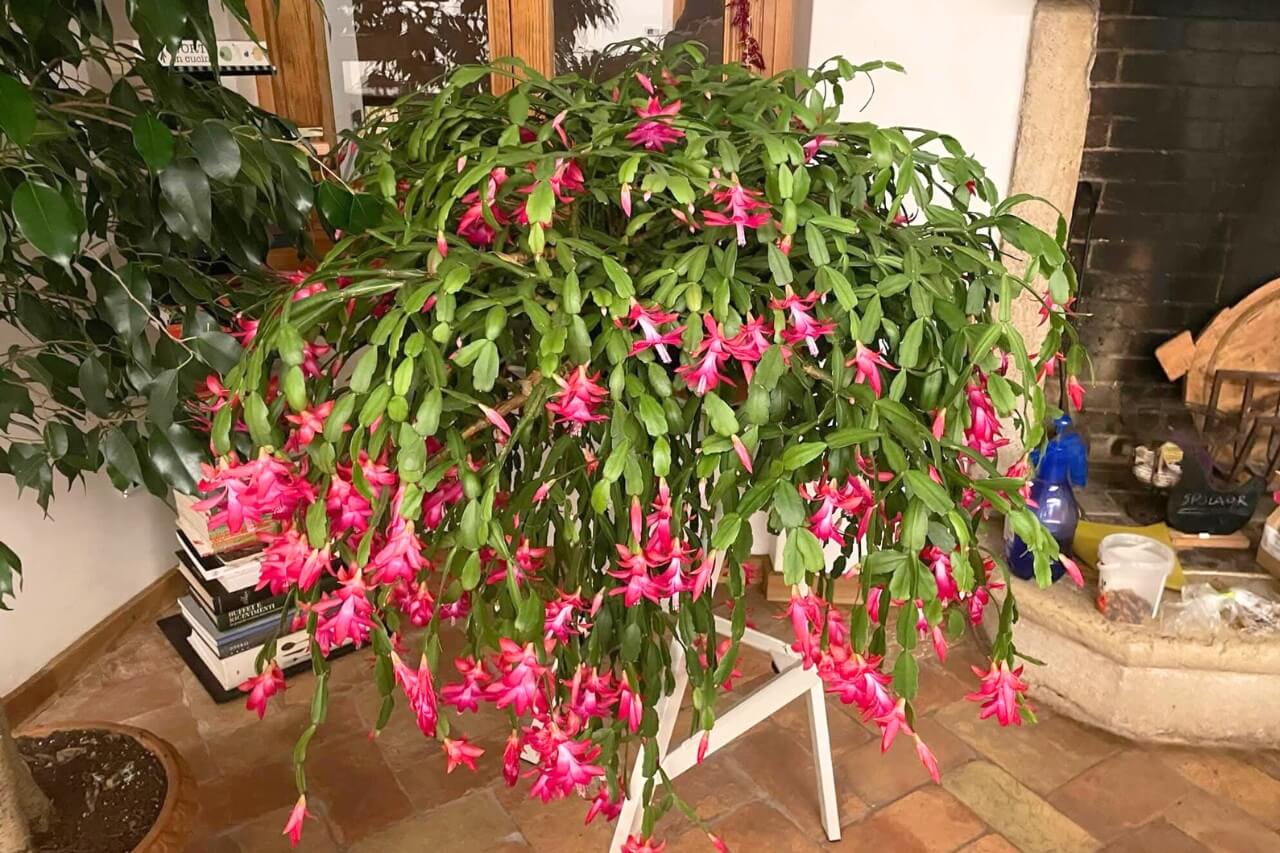The Christmas cactus is my favorite holiday plant. I am fascinated by its stems that droop downward and end in beautiful red or pink flowers.
I also love it because it’s a plant that lasts a long time and can truly be with you for part of your life.
Just consider that there are people who have had one for decades, and with the right care, it can remain healthy for a long time.
For this ìreason, in this article, we will look at some tips for growing a Christmas cactus to perfection and some common mistakes to avoid.
Tips for a Thriving Christmas Cactus
Bright But Indirect Light
The first thing you have to do is to place your Christmas cactus near a bright window, but out of harsh direct sunlight.
Consider that Christmas Cactus thrives in bright and indirect light, so it’s better to opt for an east- or west-facing window.
Unfortunately, intense midday sun can scorch the leaf segments, so you really have to avoid it.
Moderate Watering
Another thing you have to do is to keep the potting mix evenly moist but never waterlogged.
Always allow the top inch of soil to dry out before watering again.
In addition, pour off any excess water from the saucer. Overwatering is very dangerous for these kinds of plants.
PRO GARDENER: If you’re overwatering, you’ll see soft and blackened segments.
Well-Draining Soil and Potting
As the name suggests, this plant is still a cactus, so use a porous, well-draining potting mix high in organic matter.
A commercial cactus/succulent mix or a 60% peat–40% perlite blend works well.
These cacti actually bloom best when slightly root-bound, so don’t use a pot that’s much too large.
Repot only when roots are very crowded, and if you do so, use a fresh mix to ensure good drainage.
Warm and Stable Temperature
In terms of temperature, they prefer 65–75°F (18–24°C) during the day and can handle cooler nights, but generally above 50°F
Many people ask me if it can withstand extreme cold. Well, it can handle brief dips below 50°F but cannot tolerate frost.
So during the summer, you can move it outdoors, but remember to bring it in before night temperatures fall below 50°F.
Dry indoor air is also an issue, if your home is very dry, use a pebble tray of water or occasional misting to raise humidity
Seasonal Feeding
You can feed during the active growing season (spring and summer) with a balanced (e.g. 10-10-10) liquid fertilizer.
In general, you should apply fertilizer about every 2–4 weeks while new growth is appearing. But always follow the direction of the specific fertilizer you choose.
Stop or cut back on fertilizer in fall, as excessive late-season feeding can inhibit flower bud formation.
Encouraging Winter Blooms
Christmas cactus is a short-day plant. Starting about 6–8 weeks before you want blooms (roughly early October), give it long nights and cool nights to trigger buds.
Specifically, provide roughly 12–13 hours of continuous darkness each night (e.g. by putting the plant in a dark room or covering it) and bright light during the day.
Keep nights around 55–65°F if possible. Even a brief interruption of the dark period (a hall light or streetlight) can cause buds to drop.
Also, avoid sudden changes in moisture or temperature once buds have formed.
Pruning
After your cactus finishes flowering (usually by late winter), you can prune it to encourage bushier growth.
Simply twist or pinch off a few terminal segments from each branch.
This trains the plant to branch and become fuller. Remove any leggy or dead segments at that time as well.
5 Mistakes That Will Kill Your Christmas Cactus
Overwatering/Waterlogging
As I mentioned earlier, overwatering is the most common killer.
Keeping the soil constantly soggy suffocates the roots. They really suffer root rot, the stems will turn black, mushy, and will collapse.
Always lean toward on the side of slightly dry soil rather than wet.
PRO GARDENER: If the potting mix smells musty and segments wilt easily, the roots are likely rotting.
Excessive Direct Sun
I’ve already said this, but I’ll say it again, since it’s another very common mistake.
Although this cactus likes bright light, avoid intense direct sun (especially hot midday light).
Symptoms of this mistake include red or yellowish browning and crispy tips. If you notice that, move your plan to another place (avoid very hot south windows).
Freezing Temperatures
Christmas cacti cannot tolerate frost. Constant temperature below 50°F can kill tissue.
In this case, cold-damaged segments will turn black and water-soaked.
You should treat Christmas Cactus like a tender tropical; room temperature is usually ideal.
Severe Underwatering
While overwatering is the bigger concern, leaving a Christmas cactus dry for weeks can also be fatal.
In extremely dry soil the segments shrivel and shrivel to a papery state.
The plant will wilt and eventually die. Additionally, any developing buds will fall if the plant becomes too dry.
Poor Drainage
Even if you water properly, heavy or compacted soil can trap moisture. Using a dense potting mix or a pot with no drainage holes will keep roots wet and cause rot.
Poorly drained soil promotes the development of root-rotting fungi that kill the plant.
Always use a loose and well-draining mix and a pot with drainage holes.

